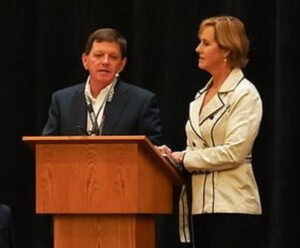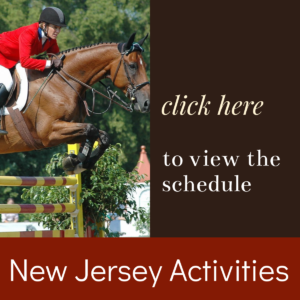The new Channel System that went into effect this month for the 2023 season has nothing to do with TV. It’s an initiative for restructuring horse show competition licensing that takes some explaining, which is just what happened today during a forum at the U.S. Hunter Jumper Association’s annual meeting in Washington State
Britt McCormick, a member of the USHJA board, sees the system “as a way to broaden our sport, to grow the grassroots, a way to put something out there that is innovative; something different, something new.”
USHJA President Mary Knowlton, presiding at the State of the Association meeting, said the concept, implemented through the U.S. Equestrian Federation, started with the USHJA as an answer to the eternal question about showing, “Can we make a more affordable experience for exhibitors?”
The idea is “to open the competition calendar to more horse shows and to provide a robust program of awards for the regional level–an awards program equal to the program that exists now for the top of sport,” said Sissy Wickes, who served with Britt on the USEF Competition Task Force that created the Channel System proposal. It eases the mileage rule, which for decades had been an impediment to the growth of new shows.

Britt McCormick and Sissy Wickes. (USHJA photo)
Some find the Channel System a concept that they just can’t get their heads around, however.
“I would definitely say that there are moments when people are struggling with feeling overwhelmed and pushed down by the Channel System,” noted Mary.
It likely won’t be everyone’s choice, mused Britt, chair of the USEF’s National Breeds and Disciplines Committee.
“We’re going to have a lot of people that jump on board and go, `Yeah, we love it.’ We’re going to have people that just say, `This isn’t for me and I’m going to go somewhere else.’ ”
He added, “We’re not trying to be all things to all people. We’re trying to encourage people to collaborate in their area… the idea is that organizers…figure out how to do circuits….and how to share the limited pool of exhibitors that is in their area, if that’s the case.”
USEF President Tom O’Mara assured those at the meeting that they “can’t find a smoke-filled room where people sit making rules to make other people’s lives miserable.”
He noted the Channel System generated “huge feedback. thousands of surveys came back.” He called the effort to devise the rule “supercollaborative. If there are things that need to be adjusted, they will be adjusted.”
Shelley Campf, chair of the USEF’s Member Services Council, is concerned that the system could “really affect the viability of shows.” She noted that in her home zone in the Pacific Northwest, “there are not that many people to go around.”
“When the weather is such that you can show locally,” Shelley said, she would like “USHJA help foster local programs, even if it’s at the Channel 1 level.”
A rotating team of presenters commented on other matters at the meeting. Joe Dotoli, who shepherded the Helmet Ratings initiative, noted that with sponsorship from Jacqueline Mars, USEF and U.S. Eventing Association, the project wound up costing USHJA only 75 center per member.
“That’s a pretty good return,” said Joe.
“It is a huge jump forward in the safety of our sport,” he continued, noting USEF has come a long way since the first helmet safety rule in 2001.
To read about the helmet study, click on this link. For the helmet manufacturers’ reaction, click here.
So what safety project is on the horizon now? That would be a study of the air vests riders are wearing in increasing numbers.
“Many of us think the next logical step is airbags, which is what air vests are,” said Joe, who had compared the helmets to automobile seatbelts in the way they progressed. He noted, however, there is less information available on the effectiveness of the vests than there was on the helmets, so he expects that study “will take longer and probably be more expensive. But that’s the route I”m sure our safety committee is going to be promoting next.”
Another important development is the growth of the Outreach program, which introduces riders to USHJA and the USEF.
In 2014, there were 93 Outreach competitions with 318 riders. In 2022, with “Outreach 2.0,” that had swelled to 654 competitions and 7,500 riders. Some Outreach classes are part of a show; others are stand-alones.
“Outreach for us is a give-back to our the sport,” Mary said. “It’s not a money-making endeavor. It’s our way of reaching out to the unrecognized (show) world,” she explained.
“It’s a way to make connections.”
The USHJA is reaching out in many ways. As Mary put it, “We’re offering a lot of success to people across many, many platforms.”





